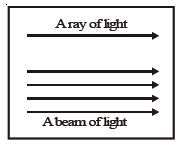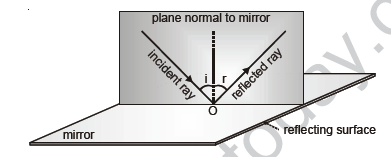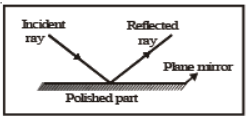Download
CBSE Class 8 Science Light Notes in PDF format. All Revision notes for
Class 8 Science have been designed as per the latest syllabus and
updated chapters given in your textbook for Science in Class 8. Our
teachers have designed these concept notes for the benefit of Class 8
students. You should use these chapter wise notes for revision on daily
basis. These study notes can also be used for learning each chapter and
its important and difficult topics or revision just before your exams to
help you get better scores in upcoming examinations, You can also use
Printable notes for Class 8 Science for faster revision of difficult
topics and get higher rank. After reading these notes also refer to MCQ questions for Class 8 Science
Revision Notes for Class 8 Science Chapter 16 Light
Class
8 Science students should refer to the following concepts and notes for
Chapter 16 Light in Class 8. These exam notes for Class 8 Science will
be very useful for upcoming class tests and examinations and help you to
score good marks
Chapter 16 Light Notes Class 8 Science
CBSE
Class 8 Science Light Chapter Notes. Learning the important concepts is
very important for every student to get better marks in examinations.
The concepts should be clear which will help in faster learning. The
attached concepts made as per NCERT and CBSE pattern will help the
student to understand the chapter and score better marks in the
examinations.
LIGHT
WHAT IS LIGHT?
If we enter a dark room, the objects present in the room are not
visible. However, if we switch on a bulb, everything in the room becomes
visible. Why? The bulb gives out an invisible energy called light. When
this energy falls on the objects in the room, it bounces off from the
surface of objects. When this energy enters our eyes, the eyes sense it
and send a message to the brain. It is finally, the brain which really
sees the objects. Eyes are only an aid in seeing the objects around us.
Why do we say that light is invisible ? Well, when light energy falls on
the objects, we really do not see it. When energy bounces off from the
surface of objects and enters our eyes, the sensation produced by this
energy, helps our brain to see. Thus, to sum up we can say :
Light
is an invisible energy, which causes in us the sensation of vision. When
the light falls on any object, it bounces off from the surface of the
object in all directions. This is called scattering of light.
DEFINITION
Light is form of energy which enables us to see objects which emit or
reflect light. Light is a type of (form of) energy which can produce
sensation in our eyes. So we can experience the sensation of vision.
It is travel in straight line in form of particles and waves. With the
help of light we see all colours of nature. Our eyes are mostly
sensitive for yellow colour and least sensative for violet and red
colour. Due to this reason commercial vehicle's are painted with yellow
colour, sodium lamps are used in road lights.
PROPERTIES OF LIGHT
Light energy propagates (travels) via two processes.
(i) The particles of the medium carry energy from one point of the medium to another.
(ii) The particles transmit energy to the neighbouring particles and in this way energy propagates in the form of a wave.
(iii) It propagates in straight line.
(iv) It's velocity in vacuum is maximum whose value is 3 × 108 m/sec. (297489978 m/s)
(v) Light does not need a material medium to travel that is it can travel through a vacuum.
(vi) It exhibits the phenomena of reflection, refraction, interference, difraction, polarisation and double refraction.
RAY OF LIGHT
A straight line which shows, the direction of light is called ray of light.

BEAM OF LIGHT
A bunch of light rays or bundale of rays at a point is called beam of light.

HOW WE SEE ?
When a light ray is falling (strike) on the surface of any object which
reflect and reached to our eyes. Due to this our eyes feel a sensation
then we see the object.
REFLECTION OF LIGHT
When rays of light falls on any object it return back in the same
medium from the surface this phenomenon is called reflection of light.
Due to reflection of light we can see all the nature.
INCIDENT RAY
The ray of light which falls on a polished surface (or a mirror) is called the incident ray of light.
REFLECTED RAY
The ray of light which gets reflected from a polished surface (or a mirror) is called the reflected ray of light.
NORMAL
The normal is a line at right angle to the reflecting surface.

LAWS OF REFLECTION
(i) The incident ray, the reflected ray and the normal to the surface at the point of incidence all lie in the same plane.
(ii) The angle of incidence (∠i) is always equal to the angle of reflection (∠r) i.e. ∠i = ∠r

• When a ray of light falls on a mirror normally or at right angle it gets reflected back along the same path.

Depending on the nature of the reflecting surface there are two types of reflection :-
(i) Regular (specular) reflection (ii) Irregular (diffused) reflection
REGULAR REFLECTION
When
parallel light rays fall on smooth plane surface like mirror, if all
rays of light are reflected parallely along a difinite direction. Then
this kind of reflection is called regular reflection.
IRREGULAR REFLECTION (DIFFUSED REFLECTION)
When
paraller light rays fall on a rough surface all the rays of light are
reflected in all possible (Different) direction this is called diffused
or irregular reflection.
REFLECTING MATERIAL
The material or matter which reflect the light rays is called reflecting material. There are two types of reflecting material.
(i) Good reflector
(ii) Deem reflector
(i) Good reflector : The material which reflect all the incident light rays is called good reflector.
O R
This types of reflectors are reflected maximum incident light rays these type of reflector makes regular reflection like mirror.
(ii) Deem (Midium) Reflector :
In this type of reflector, mostly part of incident rays are reflected.
But some part is observed or transmitted by them irregular or diffused
reflection are made by them like rough surface.
For making a reflector, a glass plate is polished one side by silver or nickel type material.
PRACTICE PROBLEMS
FILL IN THE BLANKS
(i) Impression of an image persists for .................. of the second on retina.
(ii) Angle of reflection is always .................. to the angle of incidence.
(iii) .................. is a small opening in the corner.
(iv) Cones are sensitive to .................. light.
(v)
Muscles attached to the eye lens .................. and the lens
becomes .................. when distant objects are to be seen.
(vi) To keep our eyes fit our diet should include vitamin .................. rich eatables.
(vii) Impression of an image is formed on ..................
(viii) Braille system has .................. dot patterns.
(vii) Cones (g) controls the size of the pupil
TRUE OR FALSE
(i) Both incident ray and reflected ray lie in the same plane. [ ]
(ii) Diffused reflection is due to the failure of the laws of reflection. [ ]
(iii) The image formed by plane mirror is laterally inverted. [ ]
(iv) The iris is the coloured part of the eye. [ ]
(v) Rods are sensitive to bright light. [ ]
(vi) Changing of the thickness of the eye lens is called accommodation. [ ]
A smooth, highly polished reflecting surface is called a mirror.
When a glass plate is polished on one sided with reflecting material such silver or nickel then is becomes a mirror.
From the reflecting surface of mirror there are two types of mirror.
(i) Plane mirror (ii) Spherical or curved mirror
(i) Plane mirror :
A highly polished plane surface is called a plane mirror or if a flat
(totally plane) surface of a glass plate is polished one side of
reflecting material is called plane mirror.

(ii) Spherical mirror :
A mirror whose polished, reflecting surface is a part of hollow sphere
of glass is called a spherical mirror. For a spherical mirror, one of
the two curved surfaces is coated with a thin layer of silver followed
by a coating of red lead oxide paint. Thus one side of the spherical
mirror is made opaque and the other side acts as a reflecting surface.
For the polishing side there are two type of spherical mirror.
(A) Concave (Converging) mirror : A spherical mirror whose inner hollow surface is the reflecting surface.
(B) Convex (diverging) mirror : A spherical mirror whose outer bulging out surface is the reflecting surface.
FORMATION OF IMAGE IN A PLANE MIRROR
P
is an object which is placed in front of a plane mirror AB as shown in
fig. Rays PO and PO' starting from P falls on mirror then these rays are
reflected in OR and O'R' directions respectively. When the reflected
rays enter the eye then they appear to diverge from P'. P' is called the
image of object P.
Following are the properties of the image formed by a plane mirror
(i) Image is always virtual
(ii) Image lies as far behind the mirror as the object is infront of it.
(iii)
The size of image is the same as the object. The only difference is
that the right side of an object appears to be left in the image and
vice versa. This effect is known as lateral inversion. Lateral inversion
is shown in fig.
USES OF PLANE MIRRORS
(i) They are used as looking glass.
(ii) They are used by barbers to show the customer the back side of his head.
(iii) They are used for signalling by the scouts and the army personnel.
(iv) They are used by the opticians to provide false dimension, when their place of work is very small.
(v)
They are used for providing false dimensions in show cases, displaying
jewellery, wrist watches, etc. Two plane mirrors are fixed to the
opposite sides of the show case, such that their reflecting surfaces
face each other. This leads to the formation of multiple images.
(vi) They are used for reflecting the rays of the sun inside the solar cooker.
(vii)
They are used for making toys like kaleidoscope. In this toy, three
plain mirrors are inclined at an angle of 60°, and fixed in a tube. Some
broken bangles are placed inside the tube. When the tube is turned, the
image of bangles form beautiful hexagonal patterns.

(a) Aperture : The effective width of a spherical mirror from which reflection can take place is called its aperture.
(b) Pole (Vertex) : The centre of a spherical mirror is called its pole it is denoted by letter P.
(c) Centre of curvatue :
The centre of the hollow sphere of which the spherical mirror is a part
is called centre of curvature. It is denoted by letter C.
(d) Radius of curvature : The radius of the hollow sphere of which the spherical mirror is a part called the radius of curvature (R).
(e) Principal axis : The straight line passing through the centre of curvature C and the pole P of the spherical mirror.
(f) Normal :
The normal at any point of the spherical mirror is the straight line
obtained by joining that point with the centre of curvature C of the
mirror.

